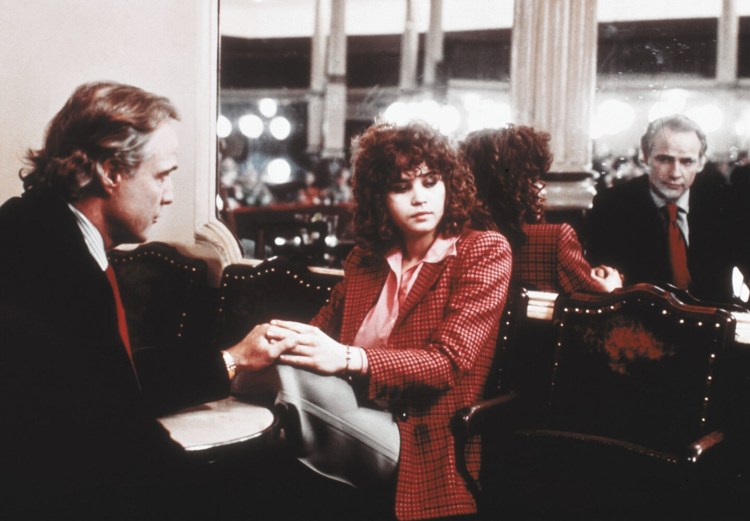Who is this strange middle-aged man on the bridge, clasping his hands to his ears to silence the roar of a passing train, his mouth open in a silent scream like the figure in Edvard Munch’s famous painting, his eyes closed?
Some will gasp, “Is that Vito Corleone? No, too young.”

“Stanley Kowalski? No, too old.”
In Bernardo Bertolucci’s 1972 film, based on an original screenplay by Franco Arcalli and himself, he does looks a bit like Terry Malloy from the docks of New Jersey. But it can’t be. Yes, it is. It’s Marlon Brando.
The credits tell us this man is Paul, a middle-aged American expatriate in a cheap T-shirt and an expensive camel-hair topcoat. He is clean-shaven but needs a haircut. Bertolucci’s description at the time, he is “a small-time boxer, one-time actor and drummer, wandering the streets of Paris, despondent over the suicide of his adulterous French wife.”
The playbill tells us that Paul is a “confused, tortured, sexually aggressive expatriate whose wife has just committed suicide.” Oh Lord! As Oliver Hardy would say, “What a mess we’ve gotten ourselves into now.”
The plot is simple. Paul is looking for a cheap apartment to begin a new chapter in what he has left of his sordid life.
He meets a young girl named Jeanne (Maria Schneider), who also is looking for a place.
Jeanne is exhausted from trying to help her talentless documentary filmmaker boyfriend put together his work.
She and Paul meet in the empty apartment, and within minutes begin to embark on a sexual tryst that lasts for three days. The opening scene, like many in the picture, happens even before they shake hands. Paul throws her up against the wall and to the floor and proceeds to make her an offer she cannot refuse.
For three days, they engage in sexual sadomasochistic games. Yes, they do.
Paul is insistent that they reveal nothing of themselves, not even their names.
“We’re going to forget everything, no names, nothing.”
For those of you old enough to remember the infamous “butter lubricant rape scene” that caused a scandal even in France, be prepared. It is here. The scene, we’re told, wasn’t in the original script. It was Marlon’s idea.
In all of the reporting done on the film since its opening in 1972, hundreds of stories have been told of how Bertolucci, obsessed with Brando, finally gave him complete control of the story line.
According to Schneider, now deceased, “Bertolucci was in love with Brando, and that’s what the movie is about.”
Make of all that what you will, but the final print with all of the sex, female nudity (Brando, except for the backs of his legs, is always clothed) is here. Critic Judith Crist famously said it was made in “the male-chauvinist tradition.”
For a completely detailed story of those days in Paris, I would recommend Stefan Kanfer’s book “Somebody: The Reckless Life and Remarkable Career of Marlon Brando.” It’s all there.
Actually, there is more sex talk by Brando than copulation. But some should be prepared to be shocked and disgusted by Brando’s appeals to Schneider.
Surprisingly, there is some humor in the film. Paul takes Jeanne to a dance hall tavern where a tango festival is in progress. He gets her drunk and interrupts the contest by taking her to the floor and flopping, twisting and leaping about; they are dragged from the floor. Then Brando, as Paul, drops his trousers and “moons” the audience.
It’s important, for those of you who weren’t around in those heated moments, to keep in mind that Bertolucci was, in his halcyon days, one of Europe’s greatest directors.
This was the man who made the “The Conformist.” And his brilliant “The Last Emperor,” which won all nine of the Oscars for which it was nominated, also gave him Best Director and Best Adapted Screenplay. For “Tango,” he was nominated for Best Director and Brando for Best Actor.
Bertolucci went on to make “1900,” a multi-generational family saga with a large international cast that included Robert De Niro, Gérard Depardieu, Burt Lancaster, Donald Sutherland and Dominique Sanda.
Brando, we must remember, will always be remembered as one of cinema’s and the stage’s greatest actors. In his last years, he was numbed by the failure of 11 pictures in a row; and despite his stunning “Godfather,” he ended his life in darkness and disease.
Even here, in this shambolic attempt at art, he has moments that make us remember his finest work.
The ending is for you to decipher. But if you are a film buff and amateur historian, this movie is a must-see. I should add, however, if you have pearls, prepare to clutch them. “Last Tango” is not, as they say, for the faint of heart.
J.P. Devine, of Waterville, is a former stage and screen actor.
Send questions/comments to the editors.



Comments are no longer available on this story